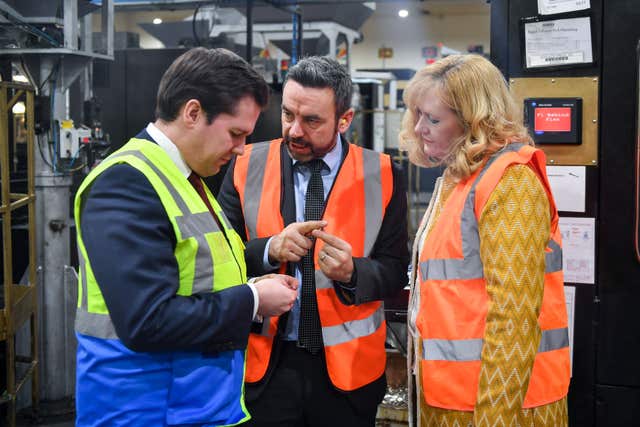
The Royal Mint has appointed its first female chief executive in its 1,100 year history.
Anne Jessopp was on Friday named the organisation’s new chief executive and deputy master.
The Mint said she will spearhead work to provide Britain with “cutting-edge secure currency” and develop the commemorative coin and bullion arm of the business.
The Royal Mint produces up to 90 million coins every week and one of Ms Jessopp’s first jobs will be overseeing the introduction of the new 50p coin, which will mark the centenary celebrations of women’s suffrage.
 Robert Jenrick, exchequer secretary to the Treasury, and Anne Jessopp are shown coins on the production line at the Royal Mint factory in Llantrisant (Ben Birchall/PA)
Robert Jenrick, exchequer secretary to the Treasury, and Anne Jessopp are shown coins on the production line at the Royal Mint factory in Llantrisant (Ben Birchall/PA)
Ms Jessopp said: “I am delighted to be appointed to lead this unique and important British organisation.
“The Royal Mint has an impressive history of over 1,100 years and its longevity is due to its ability to adapt as society changes.
“This was never truer than today, as we reinterpret The Royal Mint for the 21st century, building on the values that have been at the heart of the organisation throughout our history – authenticity, security, precious metals, craftsmanship and design.”
Her first ceremonial role will be to lead the annual Trial of the Pyx, which was first held in 1282 to test the integrity of the nation’s coins, ensuring they are the proper weight and size, and contain the right amount of precious metals.
The Mint noted: “Remarkably, the history books reveal that if the coins fail the test, the Chancellor of the Exchequer, who is the ceremonial Master of the Mint, risks losing a hand as punishment.
“It should be made clear that in the trial’s long history, 94 Minters have had their right hands cut off by order of the King.
“However, this has not happened for hundreds of years.”


Why are you making commenting on The Herald only available to subscribers?
It should have been a safe space for informed debate, somewhere for readers to discuss issues around the biggest stories of the day, but all too often the below the line comments on most websites have become bogged down by off-topic discussions and abuse.
heraldscotland.com is tackling this problem by allowing only subscribers to comment.
We are doing this to improve the experience for our loyal readers and we believe it will reduce the ability of trolls and troublemakers, who occasionally find their way onto our site, to abuse our journalists and readers. We also hope it will help the comments section fulfil its promise as a part of Scotland's conversation with itself.
We are lucky at The Herald. We are read by an informed, educated readership who can add their knowledge and insights to our stories.
That is invaluable.
We are making the subscriber-only change to support our valued readers, who tell us they don't want the site cluttered up with irrelevant comments, untruths and abuse.
In the past, the journalist’s job was to collect and distribute information to the audience. Technology means that readers can shape a discussion. We look forward to hearing from you on heraldscotland.com
Comments & Moderation
Readers’ comments: You are personally liable for the content of any comments you upload to this website, so please act responsibly. We do not pre-moderate or monitor readers’ comments appearing on our websites, but we do post-moderate in response to complaints we receive or otherwise when a potential problem comes to our attention. You can make a complaint by using the ‘report this post’ link . We may then apply our discretion under the user terms to amend or delete comments.
Post moderation is undertaken full-time 9am-6pm on weekdays, and on a part-time basis outwith those hours.
Read the rules here